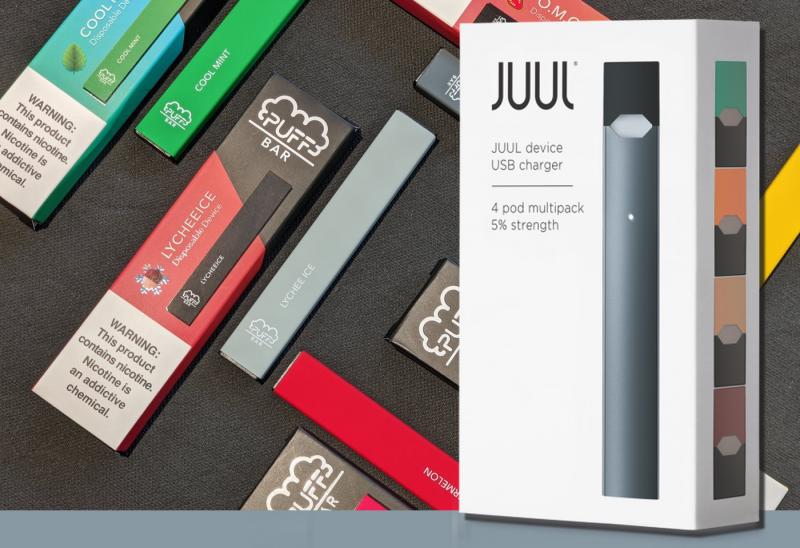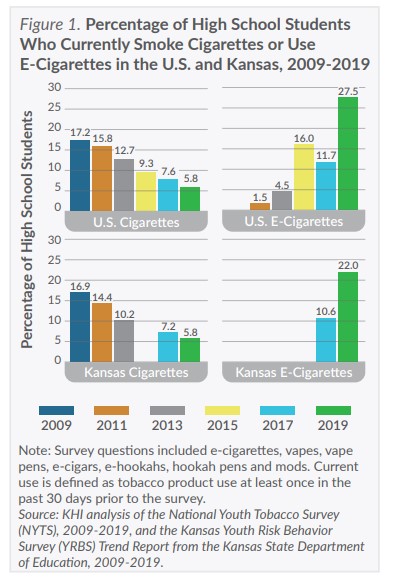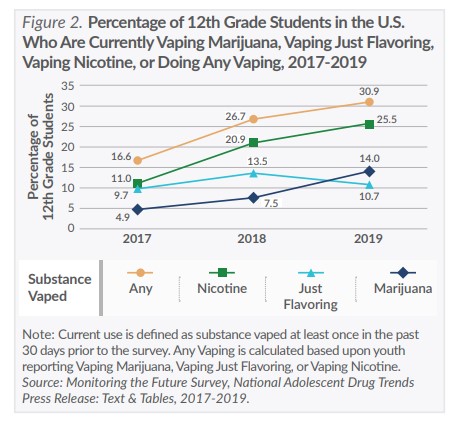Online sales and delivery services (26 states, not Kansas): In the absence of federal regulation under the Prevent All Cigarette Trafficking Act (the PACT Act), states generally have enacted legislation to restrict online sales and shipments of e-cigarettes as well as regulate delivery services, which are generally app-based or on-demand retailers. States have enacted regulatory strategies such as prohibiting shipments, specifying a particular method of delivery, requiring packages to be labeled as containing tobacco, limiting the quantity of shipments and requiring age-verification at the time of delivery.
Taxation (22 states and D.C., including Kansas): Generally, states have imposed an excise tax on the wholesale value of the e-cigarette product, or on the volume of e-liquid contained in the e-cigarette product. In contrast, traditional cigarette taxes are typically levied per cigarette. The Kansas Legislature enacted a privilege tax for the sale of consumable e-liquid in 2016 of $0.20 per milliliter, but then reduced the amount of the tax to $0.05 per milliliter in 2017. Other states have enacted taxes, such as Ohio, which has an excise tax of $0.01 per vapor volume, and New York, which has a tax of 20 percent on the retail price of all vapor products.
Retail licensure (31 states and D.C., including Kansas): States generally require retailers to obtain a license before selling tobacco products and may revoke or suspend a license if the retailer violates the law. Fees generated from licensing laws can provide stable and reliable funding for regulatory actions such as retailer inspections. Under licensing laws, states also have reduced or restricted the number, location, density, and types of tobacco retail outlets; limited point-of-sale advertising and product placement; and required retailers to comply with other tobacco control measures.
During the 2020 session, the Kansas Legislature considered two bills:
-
- House Bill (HB) 2450: Introduced on January 16, this bill would have amended the Kansas Indoor Clean Air Act to add the use of an electronic cigarette to the definition of smoking. HB 2450 died when it was stricken from the House calendar.
- HB 2563: Introduced on February 4, this comprehensive bill would have amended Kansas law to conform with the federal T21 law, added use of an electronic cigarette to the Kansas Indoor Clean Air Act, prohibited cigarette vending machines, and prohibited flavored vaping products, except tobacco- or menthol-flavor. The bill did not have a provision addressing online and delivery sales. HB 2563 passed favorably out of committee but received no further action in the House.
Although there was no state law enacted by the Kansas Legislature, other officials in the state have taken action. Fourteen Kansas localities have amended their clean indoor air ordinances to include e-cigarettes and 29 Kansas localities have adopted T21 in local ordinances as of May 2020. In addition, the Kansas State Board of Education (KBOE) convened a task force to study six topics last year, including state policy, regulation and enforcement, awareness, education, web-based central hub, and modification of health standards. In December 2019, KBOE approved a policy encouraging adoption of a comprehensive tobacco-free school grounds policy that includes vaping.
Conclusion
The rapidly changing e-cigarette product landscape, the rising rates of e-cigarette use among young people, and the EVALI outbreak present challenges to regulators and legislators. Despite the many actions taken at the federal, state and local levels across the United States, concerns about a new generation addicted to nicotine products continue to compel policymakers, school officials, public health officials and other stakeholders to work collaboratively to reduce the use of e-cigarettes.



